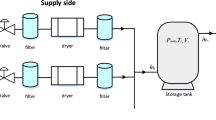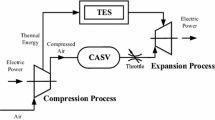Abstract
This paper presents a simple analytical model for a compressed air system (CAS) supply side. The supply side contains components responsible for production, treatment and storage of compressed air such as a compressor, cooler and a storage tank. Simulation of system performance with different storage tank size and system pressure set-point were performed. Results showed that a properly sized tank volume reduces energy consumption while maintaining good system pressure stability. Moreover, results also showed that reducing system pressure reduced energy consumption, however a more detailed model that considers end-user equipment is required to study effect of pressure set-point on energy consumption. Future work will focus on develo** a supply-demand side coupled model and on utilizing model in develo** new control strategies for improved energy performance.
You have full access to this open access chapter, Download conference paper PDF
Similar content being viewed by others
Keywords
1 Introduction
Compressed air has been considered safe, easy to use, store and transport [1]. Because of these and other favourable characteristics, compressed air has been widely used in industrial plants [2]. CAS have been characterised by their low energy efficiency; 81% or more of energy supplied to CAS was wasted [3]. A modern CAS is formed of several sub-components [4], as shown in Fig. 13.1. It has been common to divide the compressed air system into a supply and a demand side. The supply includes components where compressed air was produced, treated and stored (compressor, cooler, filter, dryers, tank, etc.) while the demand side consisted of the distribution network and pneumatic devices.
Evaluating system performance through computer simulations can be effective for studying performance improvement measures. Friedenstein et al. presented in [5], a method to assess energy efficiency measures via computer simulation. The method had three main parts: system investigation, model creation and simulation. Maxwell and Rivera simulated in [6] the effect of different CAS control strategies on energy performance. Kleiser and Rauth studied in [7] system performance with different storage tank volumes was studied. In [8], Anglani et al. introduced a new tool that allowed a user to simulate different CAS components, configurations and settings.
This paper investigates a simplified model that can serve as a first tool for CAS design or retrofit evaluation. In Sect. 13.2, the mathematical models for the compressor, cooler and storage tank are presented. Section 13.3 evaluates, two different system modifications using the model: varying storage tank volume and decreasing system pressure. Finally, some conclusions and future work are presented.
2 Modelling Individual Components
2.1 Compressor
Assuming air behaved like an ideal gas, the work required (Wcomp) to compress a volume (V1) of air from air inlet pressure (P1) to discharge pressure (P2) was calculated using Eq. (13.1) [8].
where (n) is the polytropic compression exponent. The process was assumed to be isentropic and n = 1.4. To calculate the power, volume flow rate per unit time was used instead of volume. To estimate the power (Wsup) supplied to the compressor, efficiencies of the drive system (ηds) and the compressor (ηc) were assumed constant at 90% and 80% respectively.
2.2 Air Cooler
In this study a counter flow air to air heat exchanger with effectiveness (ε) was assumed. The temperature of air leaving the cooler (T3) was obtained using Eq. (13.2) [9].
Tamb is the temperature of ambient air, which was assumed to be the cooling fluid. T2 is temperature of air exiting the compressor and was obtained from ideal gas law.
2.3 Storage Tank
The purpose of a storage tank in a CAS was to store compressed air for when it was needed. Often, the pressure of air in storage was used as a control variable for the compressor. From the law of mass conservation, the mass of air in the storage tank was obtained with Eq. (13.3).
min and mout were the air mass flowing in and out of the tank. m0 is the mass of air in the tank at time t = 0. Assuming the temperature of air in the tank was equal to temperature of air leaving the cooler (T3), the pressure of air in a tank (Ptank) of volume (Vtank) was obtained with Eq. (13.4) [6], where (R = 287 J/kg·K) is the gas constant of Air.
3 Simulation and Results
The mathematical model of the components presented in Sect. 13.2 were implemented in MATLAB. The compressor had a load/unload control, so the compressor would run at partial capacity (20%) for a period of time before shutting off. The system was assumed to leak 7% of its rated air capacity. System performance with no compressed air consumption, apart from leaks in the system, was simulated. Storage tank pressure is shown in Fig. 13.1. The load/unload control settings caused the tank pressure to cycled between the upper (9 bar) and lower (5 bar) pressure limits. In this case, consumption was only due to assumed leaks in the system.
3.1 Storage Tank Size
The impact of changing tank volume was studied. The compressed air consumption profile shown in Fig. 13.2 was assumed. Three different simulations with tank storage volumes of 100, 330 and 930 l were performed. The results compressor energy consumption and tank pressure are shown in Table 13.1 and Fig. 13.3 respectively. Results showed that a larger tank volume had a higher pressure stability, however this stability was not always justified in terms of energy consumption. The highest energy consumption was for the 930 l tank, while the lowest was for the 330 l. Further analysis is required to study energy consumption for different compressed air consumption profile (Fig. 13.4).
3.2 System Pressure
Reducing system upper pressure limit from 9 to 8 bar was simulated assuming a tank volume of 330 l and the air consumption profile shown in Fig. 13.2. Energy consumption at different pressure levels is shown in Table 13.2. Results show that reducing system pressure led to 7% reduction in energy consumption. It should be noted that this model assumed constant compressor efficiency at different discharge pressures. In reality, efficiency varies with air discharge pressure. Moreover, leakage rate, which was assumed constant, changes proportionally with system pressure. Decreasing system pressure removes artificial demand in pneumatic tools. This could be better analysed through modelling the demand side of the system.
4 Conclusion
A simplified CAS model was presented. Mathematical expressions that describe compressor, cooler and storage tank were implemented in MATLAB. Different air storage tank volumes and different system pressure levels were simulated. Results for tank volume show that too large or too small a tank led to excessive energy consumption. An adequate tank volume reduced energy consumption while maintaining system pressure stability. Moreover, simulation results showed that reducing system pressure reduced energy consumption, however a more detailed model that considers demand side is required to properly analyse the effect of system pressure on energy consumption. Future work will investigate model validation and develo** a supply-demand coupled model. Moreover, development of novel control strategies to reduce energy consumption will be studied.
References
T. Nehler, Linking energy efficiency measures in industrial compressed air systems with non-energy benefits–a review. Renew. Sustain. Energy Rev. 89, 72–87 (2018). October 2017. https://doi.org/10.1016/j.rser.2018.02.018
R. Saidur, N.A. Rahim, M. Hasanuzzaman, A review on compressed-air energy use and energy savings. Renew. Sustain. Energy Rev. 14(4), 1135–1153 (2010). https://doi.org/10.1016/j.rser.2009.11.013
M. Benedetti, F. Bonfa, I. Bertini, V. Introna, S. Ubertini (2018) Explorative study on Compressed Air Systems’ energy efficiency in production and use: first steps towards the creation of a benchmarking system for large and energy-intensive industrial firms. Appl. Energy 227, 436–448 (2018). June 2017. https://doi.org/10.1016/j.apenergy.2017.07.100
L. Berkeley, Compressed Air: a sourcebook for industry (2003), pp. 1–128
B. Friedenstein, J. van Rensburg, C. Cilliers, Simulating operational improvement on mine compressed air systems. South Afr. J. Ind. Eng. 29(November), 69–81 (2018)
G. Maxwell, P. Rivera, Dynamic simulation of compressed air systems, in 2003 ACEEE Summer Study on Energy Efficiency (2003), pp. 146–156
G. Kleiser, V. Rauth, Dynamic modelling of compressed air energy storage for small-scale industry applications. Int. J. Energy Eng. 3(3), 127–137 (2013). https://doi.org/10.5923/j.ijee.20130303.02
N. Anglani, M. Bossi, G. Quartarone, Energy conversion systems: the case study of compressed air, an introduction to a new simulation toolbox, in 2012 IEEE International Energy Conference Exhibition ENERGYCON 2012, (2012), pp. 32–38. https://doi.org/10.1109/EnergyCon.2012.6347776
T. Bergman, A. Lavine, F. Incropera, D. Dewitt, Fundementals of Heat and MAss Transfer (Wiley, 2011)
Author information
Authors and Affiliations
Corresponding author
Editor information
Editors and Affiliations
Rights and permissions
Open Access This chapter is licensed under the terms of the Creative Commons Attribution 4.0 International License (http://creativecommons.org/licenses/by/4.0/), which permits use, sharing, adaptation, distribution and reproduction in any medium or format, as long as you give appropriate credit to the original author(s) and the source, provide a link to the Creative Commons license and indicate if changes were made.
The images or other third party material in this chapter are included in the chapter's Creative Commons license, unless indicated otherwise in a credit line to the material. If material is not included in the chapter's Creative Commons license and your intended use is not permitted by statutory regulation or exceeds the permitted use, you will need to obtain permission directly from the copyright holder.
Copyright information
© 2021 The Author(s)
About this paper
Cite this paper
Thabet, M., Sanders, D., Becerra, V. (2021). Analytical Model for Compressed Air System Analysis. In: Mporas, I., Kourtessis, P., Al-Habaibeh, A., Asthana, A., Vukovic, V., Senior, J. (eds) Energy and Sustainable Futures. Springer Proceedings in Energy. Springer, Cham. https://doi.org/10.1007/978-3-030-63916-7_13
Download citation
DOI: https://doi.org/10.1007/978-3-030-63916-7_13
Published:
Publisher Name: Springer, Cham
Print ISBN: 978-3-030-63915-0
Online ISBN: 978-3-030-63916-7
eBook Packages: EnergyEnergy (R0)








